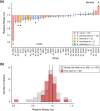The distribution of fitness effects of plasmid pOXA-48 in clinical enterobacteria
- PMID: 37505800
- PMCID: PMC10433420
- DOI: 10.1099/mic.0.001369
The distribution of fitness effects of plasmid pOXA-48 in clinical enterobacteria
Abstract
Antimicrobial resistance (AMR) in bacteria is a major public health problem. The main route for AMR acquisition in clinically important bacteria is the horizontal transfer of plasmids carrying resistance genes. AMR plasmids allow bacteria to survive antibiotics, but they also entail physiological alterations in the host cell. Multiple studies over the last few years have indicated that these alterations can translate into a fitness cost when antibiotics are absent. However, due to technical limitations, most of these studies are based on analysing new associations between plasmids and bacteria generated in vitro, and we know very little about the effects of plasmids in their native bacterial hosts. In this study, we used a CRISPR-Cas9-tool to selectively cure plasmids from clinical enterobacteria to overcome this limitation. Using this approach, we were able to study the fitness effects of the carbapenem resistance plasmid pOXA-48 in 35 pOXA-48-carrying isolates recovered from hospitalized patients. Our results revealed that pOXA-48 produces variable effects across the collection of wild-type enterobacterial strains naturally carrying the plasmid, ranging from fitness costs to fitness benefits. Importantly, the plasmid was only associated with a significant fitness reduction in four out of 35 clones, and produced no significant changes in fitness in the great majority of isolates. Our results suggest that plasmids produce neutral fitness effects in most native bacterial hosts, helping to explain the great prevalence of plasmids in natural microbial communities.
Keywords: DFE; Plasmid cost; antimicrobial resistance; carbapenemase; conjugation; enterobacteria; pOXA-48; plasmids.
Conflict of interest statement
The authors declare no competing interests.
Figures



Similar articles
-
Antimicrobial resistance level and conjugation permissiveness shape plasmid distribution in clinical enterobacteria.Proc Natl Acad Sci U S A. 2023 Dec 19;120(51):e2314135120. doi: 10.1073/pnas.2314135120. Epub 2023 Dec 14. Proc Natl Acad Sci U S A. 2023. PMID: 38096417 Free PMC article.
-
Variability of plasmid fitness effects contributes to plasmid persistence in bacterial communities.Nat Commun. 2021 May 11;12(1):2653. doi: 10.1038/s41467-021-22849-y. Nat Commun. 2021. PMID: 33976161 Free PMC article.
-
Pervasive transmission of a carbapenem resistance plasmid in the gut microbiota of hospitalized patients.Nat Microbiol. 2021 May;6(5):606-616. doi: 10.1038/s41564-021-00879-y. Epub 2021 Mar 29. Nat Microbiol. 2021. PMID: 33782584 Free PMC article.
-
Fitness Costs of Plasmids: a Limit to Plasmid Transmission.Microbiol Spectr. 2017 Sep;5(5):10.1128/microbiolspec.mtbp-0016-2017. doi: 10.1128/microbiolspec.MTBP-0016-2017. Microbiol Spectr. 2017. PMID: 28944751 Free PMC article. Review.
-
Plasmid-mediated resistance is going wild.Plasmid. 2018 Sep;99:99-111. doi: 10.1016/j.plasmid.2018.09.010. Epub 2018 Sep 21. Plasmid. 2018. PMID: 30243983 Review.
Cited by
-
The metabolic burden associated with plasmid acquisition: An assessment of the unrecognized benefits to host cells.Bioessays. 2025 Feb;47(2):e2400164. doi: 10.1002/bies.202400164. Epub 2024 Nov 11. Bioessays. 2025. PMID: 39529437 Review.
-
A plasmid-chromosome crosstalk in multidrug resistant enterobacteria.Nat Commun. 2024 Dec 30;15(1):10859. doi: 10.1038/s41467-024-55169-y. Nat Commun. 2024. PMID: 39738078 Free PMC article.
-
Ecological and evolutionary mechanisms driving within-patient emergence of antimicrobial resistance.Nat Rev Microbiol. 2024 Oct;22(10):650-665. doi: 10.1038/s41579-024-01041-1. Epub 2024 Apr 30. Nat Rev Microbiol. 2024. PMID: 38689039 Review.
-
Global epistasis in plasmid-mediated antimicrobial resistance.Mol Syst Biol. 2024 Apr;20(4):311-320. doi: 10.1038/s44320-024-00012-1. Epub 2024 Feb 26. Mol Syst Biol. 2024. PMID: 38409539 Free PMC article. Review.
-
Oral and parenteral treatment with a third-generation cephalosporin promotes the proliferation of diverse ESBL-producing Escherichia coli in the chicken intestinal tract.mSphere. 2025 Jul 29;10(7):e0022725. doi: 10.1128/msphere.00227-25. Epub 2025 Jun 27. mSphere. 2025. PMID: 40576355 Free PMC article.
References
Publication types
MeSH terms
Substances
LinkOut - more resources
Full Text Sources

